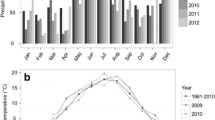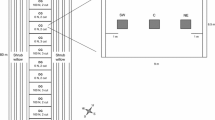Abstract
In this paper we analyzed the dry matter yields (DM) produced in an agroforestry trial consisting of pine trees grown over (1) Control (bare ground), (2) ryegrass/clovers (Lolium perene/Trifolium spp.), (3) ryegrass only, and (4) lucerne (Medicago sativa) during the third growing season between 1992 and 1993. In addition these pastures were grown alone in separate plots in the open. The results show that:
-
1.
Pasture yields during the one-year period in the agroforestry plots were little affected by the presence of trees although there were seasonal trends: yields were generally unaffected or increased in summer, but reduced in spring as a result of tree shade. Total pasture yield during the one-year period was in the following order: lucerne > ryegrass/clovers > ryegrass. This trend was the exact opposite of that shown by the above-ground tree weight which was reduced in the pasture ground covers by between 16 and 52%. The reduction in tree weights was associated with reduced soil moisture availability arising from competition with the pasture species. Thus the relationship between the yields of trees and pasture species in the agroforestry plots was reciprocal.
-
2.
The combined DM for both the trees and pastures in the agroforestry plots during the one-year period was in the following order: lucerne (20 t ha−1) > ryegrass/clovers (16 t) > ryegrass (11 t) > control (6 t) which was consistent with the total water used and photosynthetically active radiation (PAR) intercepted. The trees accounted for 55, 44, 34 and 24% of water used respectively in control, ryegrass, ryegras/cclovers and lucerne ground covers. The balance was largely accounted for by pasture transpiration, except in the control where soil evaporation was significant. The fraction of intercepted PAR accounted for by the trees followed a similar trend to that of the water used.
-
3.
The crop coefficient for water use efficiency (k) (Pa) was 2.3 for radiata pine, 3.6 for ryegrass/clovers, 2.8 for ryegrass and 4.8 for lucerne. The DM produced per unit of water used (kg mm−1 ha−1) during the one-year period was 24.5 for radiata pine, 41.1 for lucerne, 30.0 for ryegrass/clovers and 23.1 for ryegrass. Radiation use efficiency (g DM MJ−1 m−2) was 1.33 for pine, 1.83 for ryegrass/clovers, 1.49 for ryegrass and 2.34 for lucerne.
-
4.
The land equivalent ratio (LER), i.e. the sum of ratios of DM produced by the plant species in the agroforestry plots to those produced in the sole plots, was 1.95 for ryegrass, 1.71 for ryegrass/clovers and 1.45 for lucerne ground covers.
-
5.
These results indicate the susceptibility of pasture species to shading and interception of rainfall by the tree crowns (aboveground interactions), and the trees to competition for soil moisture (underground interaction).
Similar content being viewed by others
Abbreviations
- DM:
-
dry matter produced in the shoots (g m−2 or kg ha−1 or t ha−1)
- Ep :
-
transpiration through the pasture canopies (mm)
- ET:
-
evapotranspiration from the agroforestry plots (mm)
- Et:
-
transpiration through the radiata pine canopies (mm)
- GAI:
-
green area index, area of green surfaces produced by the pasture species per unit land area (dimensionless)
- k :
-
crop constant for water use efficiency (Pa)
- LER:
-
land equivalent ratio, sum of ratios of DM produced in the agroforestry plots to those in the sole plots
- PAR:
-
photosynthetically active radiation (400 to 700 nm)
- RUE:
-
radiation use efficiency, DM produced per unit PAR intercepted (g MJ m−1)
- T:
-
transpiration by the plant species (mm)
- TE:
-
transpiration efficiency, DM produced per water transpired (kg mm−1 ha−1)
- VPD:
-
vapour pressure deficit (kPa)
- WUE:
-
water use efficiency, DM produced per ET (kg mm−1 ha−1)
References
Anderson GW and Batini FE (1979) Clover and crop production under 13- to 15-year-oldPinus radiata. Aust J Exp Agric Anim Husb 19: 362–368
Blackman GE (1938) The interactions of light intensity and nitrogen supply in the growth and metabolism of grass and clover (Trifolium repens) I. The effects of light intensity and nitorgen supply on the clover content of the sward. Ann Bot 11: 257–279
Cackett KE (1964) A simple device for measuring canopy cover. Rhod J Agric Res 2: 56
Caldwell MN (1970) Plant gas exchange at high wind speeds. Plant Physiol 46: 535–537
Clinton PW and Mead DJ (1990) Competition between pine and pastures: an agroforestry study. In: Proc AFDI Biennial Conference, pp 145–154. 5–8 October, Bunbury, Western Australia
Firman DM and Allen EJ (1989) The relationship between light interception, ground cover and leaf area index in potatoes. J Agric Sci Camb 113: 355–359
FIsher NM, Raheja AK and Elemo KA (1987) Insect pest control for cowpea mixtures. Expl Agric 23: 9–20
Grace J (1981) Some aspects of wind on plants. In: Grace J, Ford ED and Jarvis PG (eds) Plants and Their Atmospheric Environment, pp 31–56. Blackwell Scientific Publications, Edinburgh
Grace J and Thomson JR (1973) The after-effect of wind on the photosynthesis and transpiration ofFestuca arundinaceae. Physiologia Pl 28: 541–547
Gregory PJ, Tennant D and Belford RK (1992) Root and shoot growth, and water and light use efficiency, of barley and wheat crops on a shallow duplex soil in a mediterranean environment. Aust J Agric Res 43: 555–559
Hawke MF and Wedderburn ME (1994) Microclimate changes underPinus radiata agroforestry regimes in New Zealand. Agric For Meteorol 71: 133–145
Linder S, Benson ML, Myers BJ and Raison RJ (1987) Canopy dynamics and growth ofPinus radiata. I. Effects of irrigation and fertilisation during a drought. Can J For Res 17: 1157–1165
Madgwick HAI (1981) Estimating the above-ground weight of forest plots using the basal area ratio method. NZ J For Sci 11: 278–286
Mead DJ and Mansur I (1993) Vector analysis of foliage data to study competition for nutrients and moisture: an agroforestry example. NZ J For Sci 23: 27–39
Mead R and Willey RW (1980) The concept of LER and advantages in yield from intercropping. Expl Agric 16: 217–228
Monteith JL, Ong CK and Corlett JE (1991) Microclimate interactions in agroforestry systems. For Ecol Manage 45: 31–44
Pollock KM, Lucas RJ, Mead DJ and Thomson SE (1994) Forage-pasture production in the first three years of an agroforestry experiment. Proc NZ Grassland Assoc 56: 179–185
Sands R and Correll RL (1976) Water potential and leaf elongation in radiata pine and wheat. Physiol Plant 37: 293–297
Tanner CB and Sinclair TR (1983) Efficient water use in crop production: research or re-search. In: Taylor HM, Jordan WR and Sinclair TR (eds) Limitations to Efficient Water Use in Crop Production, pp 1–27. ASA, CSSA, SSA, Madison, WI, USA
Turner NC (1981) Techniques and experimental approaches for the measurement of plant water status. Plant Soil 58: 339–366
Walker GK (1986) Transpiration efficiency of field grown maize. Field Crops Res 14: 29–38.
Whitehead D (1985) A review of processes in the water relations of forests. In: Landsberg JJ and Parsons W (eds) Research for Forest Management, pp 94–124. CSIRO, Melbourne, Australia
Yunusa IAM (1989) Effects of planting density and plant arrangement pattern on the growth and yields of maize (Zea mays L.) and soya bean (Glycine max (L.) Merr.) grown in mixtures. J Agric Sci Camb 112: 1–8
Yunusa IAM, Mead DJ, Pollock KM and Lucas RJ (1995) Process studies in aPinus ra radiata-pasture agroforestry system in a subhumid temperate environment. I. Water use and light interception in the third year. Agroforestry Systems 32: 163–183 (this issue)
Yunusa IAM, Sedgley RH, Belford RK and Tennant D (1993) Dynamics of water use in a dry mediterranean environment I. Soil evaporation little affected by presence of plant canopy. Agric Water Manage 24: 205–224
Yunusa IAM, Sedgley RH and Tennant D (1992) Dynamics of water use under annual legume pastures in a semi-arid mediterranean environment. Agric Water Manage 22: 219–226
Ziehm RW, Pearson HA, Thurow, TL and Baldwin VC (1992). Pine growth responses to management of the subterranean understory. Agroforestry Systems 20: 267–274
Author information
Authors and Affiliations
Rights and permissions
About this article
Cite this article
Yunusa, I.A.M., Mead, D.J., Lucas, R.J. et al. Process studies in aPinus radiata-pasture agroforestry system in a subhumid temperature environment. II. Analysis of dry matter yields in the third year. Agroforest Syst 32, 185–204 (1995). https://doi.org/10.1007/BF00711572
Issue Date:
DOI: https://doi.org/10.1007/BF00711572




